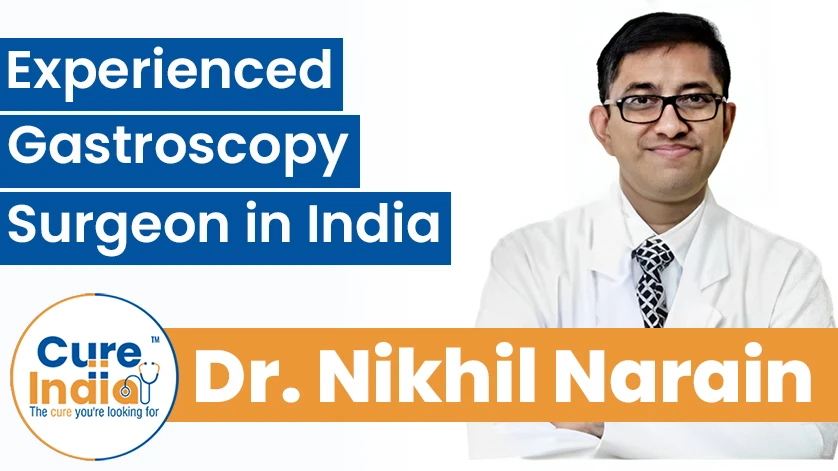

Gastroscopy, often referred to as upper endoscopy, is a diagnostic procedure that includes examining the upper part of the digestive system with the use of a thin, flexible tube called an endoscope. During an endoscopy, a little flexible tube is placed into your mouth and passed into your oesophagus, stomach, and the first portion of your small intestine before being removed. It has a light and a video camera that transfer pictures to a display where a physician may see them.
A gastroscopy often focuses on symptoms like indigestion, nausea, or trouble swallowing. Treatment for disorders like bleeding ulcers or removal of a foreign body is among the most common reasons for Gastroscopy. Polyps may be removed, and tissue samples taken by doctors.
India is one of the top destinations for gastroscopy procedure, specially for African patients. Not only do Africans gain access to specialised general surgery procedures here but do so at low prices. This page will be a patient's guide to everything and anything they need to understand about Gastroscopy procedure in India.
If you have any of the following conditions, then you may be a candidate for Gastroscopy:
The end of a gastroscopy is equipped with a video camera and a tiny light, making it a versatile diagnostic tool. The screen receives the pictures that are captured by the video camera. Putting equipment like little pincers into the tube makes it possible to collect tissue samples for examination. It is also capable of sucking air and fluids out of a particular area.
Suppose you're experiencing symptoms such as nausea and vomiting, stomach discomfort, trouble swallowing, or weight loss. In that case, gastroscopy/endoscopy is an easy and efficient way to diagnose the problem by putting a tiny camera via the mouth to receive an up-close and personal look at the digestive tract.
As a diagnostic tool for the evaluation of stomach discomfort and rectal bleeding, the colonoscopy is often advised by physicians to check out colorectal cancer in patients with a history of IBD, colon polyps that is tiny growths on the inside of the intestinal tract that may become cancerous, and other risk factors.
When dealing with stomach discomfort, acid reflux, ulcers or other upper-GI issues, a safe and accurate gastroscopy can make all the difference. India hosts leading gastroenterologists and endoscopists at well-equipped hospitals to perform gastroscopies and related procedures with considerable accuracy at affordable costs. Here are some of our best doctors for gastroscopy in India:
Dr. Anshuman Kaushal is an experienced gastroscopy doctor in India with over 24 years of experience in general surgeries. He is highly trained in therapeutic and diagnostic gastroscopy, endoscopic interventions, and upper gastrointestinal surgeries, providing patient-focused treatments with high success rates.

Dr. Atul N. C. Peters is a top-rated gastroscopy surgeon in India with over 27 years of experience in performing advanced gastroscopy and endoscopic procedures. He specialises in diagnosing and treating gastrointestinal disorders, minimally invasive endoscopic surgery, and complex upper GI interventions for precise treatments and improved patient outcomes.

Dr. Amitabha Dutta is a leading gastroscopy and endoscopy specialist in India with over 30 years of experience. His expertise in the field spans advanced diagnostic endoscopy, minimally invasive gastroscopic procedures, and management of complex GI disorders, offering patients comprehensive gastrointestinal treatments.

Dr. Nikhil Narain is an experienced gastroscopy surgeon in India with over 12 years of experience in diagnostic and therapeutic gastroscopy, upper GI procedures, and endoscopic interventions. He is known for his patient-centric treatments and provides effective treatment for a range of gastrointestinal problems.

It is necessary to have an empty stomach to conduct a precise and reliable examination; thus, you should not consume anything, not even water, beginning about 6 hours before the start of the test. Depending on when your test is planned, your doctor will be able to provide you with more particular information.
It is essential to inform your doctor of any drugs you are currently taking. If you have diabetes, you may need to alter your usual dosage during the assessment. Medical issues such as a heart ailment and an asthmatic condition should be discussed at the first consultation.
Endoscopy should not cause any discomfort. However, you are free to terminate the treatment at any point. You may have pain in your stomach and throat after a gastroscopy. In a few moments, this should go away.
An hour or two of relaxation usually puts most individuals at ease enough to go home. However, a sedative may cause you to take longer to feel well enough to drive home. Relaxation and a sense of well-being are common effects of sedatives. After taking the sedative, you must not engage in any potentially hazardous activities such as driving, operating heavy equipment, or drinking alcohol for at least 24 hours. Once you go home, you'll need someone to remain with you for the next 24 hours to ensure the effects wear off completely. After a 24-hour recovery period, most individuals may return to their regular routines.
It is possible to identify pathology with the use of Gastroscopy by helping physicians to establish what causes symptoms such as diarrhea and discomfort in the abdomen or indigestion. Then, the doctor may advance if required. An examination is carried out during the procedure of a colonoscopy:
Patients should fast for 6 to 8 hours before the EGD and wait approximately an hour before eating or drinking anything until they can easily swallow it. They should begin by drinking a glass of water. For the first 24 to 48 hours after the treatment, patients should refrain from drinking alcohol and consume readily digested meals. You may choose from a wide variety of foods such as soup and eggs.
An alternative to major skin incisions, laparoscopy enables a surgeon to see within the belly and pelvis without the need for heavy surgical instruments. Minimally invasive surgeries are sometimes known as keyhole surgery. The majority of laparoscopies are performed as outpatient surgeries. A large number of patients can go home immediately after undergoing surgery. Outpatient surgery centers and hospitals are both options for this procedure. This sort of procedure will almost certainly need general anesthesia. In other words, you won't experience any discomfort since you'll be asleep the whole time.
A laparoscope is used to perform an exploratory surgical procedure during a laparoscopy. The surgeon uses keyhole incisions to examine the organs in your abdomen and pelvis via small ports. Instead of a laparotomy, this procedure is the less invasive option.' Imaging studies have been unable to detect any issues; hence this test is often used for diagnostic reasons. The surgeon can perform a biopsy on the samples taken during the evaluation. During the laparoscopy, they might be able to cure minor abnormalities, such as removing expansion or obstructions that they uncover during the test. For instance, they may be able to do this.
The thought of undergoing medical treatment does not frighten everyone. On the other hand, many others would be quite alarmed by this. Identifying your anxiety levels is the initial step in preparing for a procedure such as an endoscopy. According to some studies, anxious persons are more prone to panic attacks during endoscopic treatments. The first step to reducing stress is to evaluate your levels and emotions of concern about the approaching surgery.
It was shown that playing soothing music during endoscopy had psychological and physiological benefits for patients. Using these trials as a basis, researchers found that music had a substantial and beneficial overall impact, lowering pain ratings, decreasing anxiety in patients, and increasing their satisfaction with the treatment.
Regardless of your level of anxiety, learning as much as possible about your upcoming surgery is always a good idea. Depending on the endoscopy performed, the patient may encounter many endoscopic procedures. Endoscopic operations may be less stressful for patients when they are better informed and more relaxed, as shown by several studies showing that patients who have received enough educational information had lower heart rates and lower anxiety levels.
You will be sent to a recovery room after the gastroscopy procedure has been completed. It is anticipated that you will be discharged to return home as quickly as feasible while maintaining a satisfactory level of health. In the case of the vast majority of individuals, this will occur within the next few hours. If you choose to receive sedation, you will need to have somebody drive you home and be with you for the next 24 hours. It would help if you also refrained from undertaking any of the activities for the next twenty-four hours after you have been sedated:
If you have received a local anesthetic spray, you should refrain from eating or drinking for one hour after the treatment. After a gastroscopy, you could have discomfort in both your stomach and your throat. This is entirely normal and ought to go away in the next several hours.
It should take you between 6 and 10 days to fully recuperate from this treatment. A rupture of the esophageal seals is possible; get medical attention as soon as possible if this occurs, and have yourself examined again if symptoms such as coughing up blood or passing blood in your feces persist. The expense of having this treatment done in India will vary depending on the quality of the facilities offered by your healthcare provider and the extent of the issues you are experiencing there. The price of this procedure is around $300.
| Treatment Name | Cost in India | Stay in India |
|---|---|---|
| Gastroscopy Procedure in India | $300 | Same Day Discharge |
